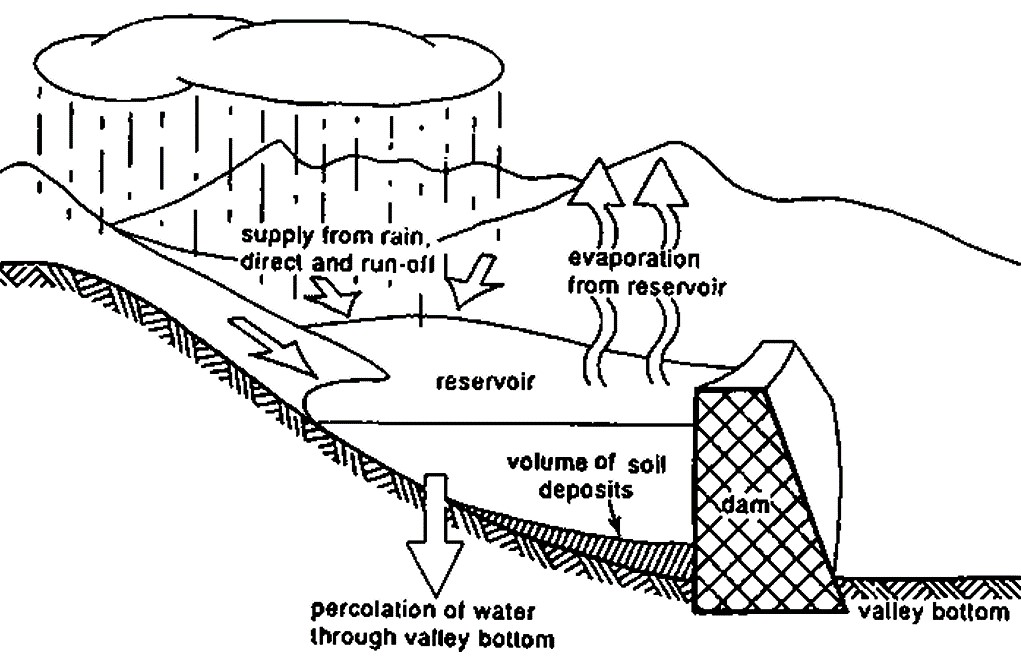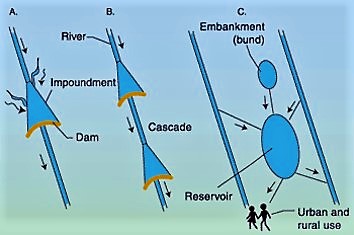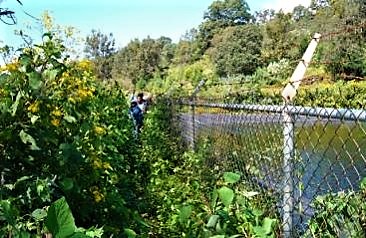Resumen ejecutivo
Man-made reservoirs, sometimes called artificial lakes, are important water sources in many countries around the world. In contrast to natural processes of lake formation, reservoirs are artificial, usually formed by constructing a dam across a riveror by diverting a part of the river flow and storingthe water in a reservoir. Upon completion of the dam, the river pools behind the dam and fills the artificially created basin (UNEP 2000). Seasonal changes of runoff and precipitation feed the reservoir. There are big differences in the size of man-made reservoirs such as big artificial lakes or small pond-like waterbodies. The stored water can be used for irrigation, drinking water after purification or to produce energy.
| Entradas | Salidas |
|---|---|
Freshwater, Drinking Water, Energy |
Introduction

A reservoir is an artificial lake called man-made reservoir. It can be formed by building a dam across a valley, by excavating the land or by surrounding a piece of land with dykes and diverting a part of the river flow into the reservoir. The water is stored in the reservoir and can be used for irrigation, hydro-power or as a water source for domestic or industry use. Man-made reservoirs are also very effective constructions to control unexpected floods (see also stormwater management). A reservoir is fed by precipitation, rainwater runoff or from a constant flow of a river. Water loss can occur due to evaporation (especially in arid regions) and depending on the reservoir bottom due to percolation (small reservoirs are often lined). Sediments from rivers or surface runoff can reduce the storage volume of a man-made reservoir significantly (FAO 1992).
Water stored in a valley usually has a higher level than the valley bottom downstream of the dam. Because of this difference in level, the valley can be irrigated by a gravity system or other distribution systems. Water can be taken from the reservoir via a concrete or steel pipe. This pipe connects the reservoir to an irrigation canal downstream. A valve is usually located on the upstream end of the pipe to control the discharge of water into the canal (FAO 1992). The kinetic energy of reservoirs is often used to produce electricity (see also hydropower small-scale and hydropower large-scale).
Ecological Impacts
Where no such water-body previously existed the presence of a reservoir in a drainage basin and the abstraction of significant water amounts for storage upstream significantly impacts the watercourse, the flora and fauna, and the human inhabitants in the drainage basin. These potential impacts should be identified and thoroughly examined prior to reservoir construction, in order to comprehensively assess the total value of the reservoir project. Procedures to identify and properly evaluate potential environmental, social and economic consequences of reservoir construction involve so-called ‘Environmental Impact Assessment’ (EIA). Such an assessment is now obligatory by law in many countries for all new dam constructions (UNEP 2000).
Ecological impacts of reservoir dams have been reported from various aspects such as barrier for migratory animals like anadromous fish, eutrophication of reservoirs by plankton blooming, decreasing flow volumes in tail waters, stabilisation of flow regimes by flood peak cut, changes in thermal regimes of river water, river bed degradation and increase in substrate grain size by sediment trapping, etc. (TAKEMON 2006). Furthermore big dams and extraction of water (e.g. for spate irrigation) can create riparian conflicts (see water conflicts). Also read the paragraph “Impact on Environment” in the rivers factsheet.

Basic Design Principles
Adapted from UNEP (2000)

Like lakes, reservoirs range in size from pond-like to very large water-bodies (e.g. Lake Powell, U.S.A.). The variations in type and shape, however, are much greater than for lakes. The term ‘reservoir’ includes several types of constructed water-bodies and/or water storage facilities:
- Valley reservoirs – created by constructing a barrier (dam) perpendicular to a flowing river.
- Off-river storage reservoirs – created by constructing an enclosure parallel to a river, and subsequently supplying it with water either by gravity or by pumping from the river.
The latter reservoirs are sometimes called embankment or bounded reservoirs, and have controlled inflows and outflows to and from one or more rivers. In addition to single reservoirs, reservoir systems also exist, and include cascade reservoirs - consisting of a series of reservoirs constructed along a single river, and inter-basin transfer schemes – designed to move water through a series of reservoirs, tunnels and/or canals from one drainage basin to another.
Pumping from a Reservoir for Irrigation
Adapted from FAO (1992)

The fields located around the reservoir upstream of a dam or surrounding a natural lake are higher than the reservoir or lake's water table. Here irrigation is only possible with the help of pumping stations, manual or motorised pumping.
The water level in the reservoir is usually highest at the end of the rainy season, and lowest at the end of the dry season or the irrigation season. Pumps installed at reservoirs and lakes must be able to handle these fluctuations, which are not only vertical, but even more pronounced horizontally, because the water recedes back to the lowest parts of the reservoir. A dead branch of a river can also be made to function as a reservoir. The branch is filled with water during the wet season and closed off during the dry season so that the stored water may be used. Due to the low water level, pumps are normally needed to irrigate fields from such a reservoir.
Costs
Especially for large reservoirs costs are high. It must be designed by engineers and heavy machinery is necessary. Furthermore, costs for material as well as O&M should be considered. If it is constructed for a hydropower water source costs are even higher because much more technical equipment as well as operation and maintenance is needed.
Operation and Maintenance
Because reservoirs are man-made water-bodies, they are more amenable to artificial operation and regulation than lakes. As previously noted, operational possibilities unique to reservoirs include the ability to discharge known volumes of water at predetermined times, and selective discharge of water from different water layers within the reservoir. This must be planned carefully as it directly impacts the environment as described above. Also read the document “Reservoir Operations and Managed Flows” (WMO and GWP 2008).
Dams, especially the very large ones, must be checked regularly to ensure their stability and security. Furthermore, many man-made water reservoirs are affected by high sedimentation rates. The accumulation of sediments in the reservoir reduces the main reservoir asset i.e. its volume capacity. Moreover sediments can negatively affect pumping and hydropower equipment.Therefore the designers should consider the soil erosion and sediment transport (CHANSON and JAMES 1998). There are several approaches to minimise or deal with sedimentation.
When a reservoir serves different functions it is nearly impossible to operate each function at its maximum level. For example, a reservoir that provides irrigation, power generation (see small scale and large scale hydropower), flood control, and recreational use may cause conflicting demands by its users (WATERENCYCLOPEDIA 2011).
Health Aspects
Faecal pollution and other contamination of reservoirs has to be prevented by wastewater treatment and buffer zones in case of non-point sources of pollution (see also the factsheets on lakes or water source and well protection). If the reservoir is also used as a source of drinking water, please also check water purification as a measure to protect human health.
It should also be considered, that surface water sources can lead to mosquito breeding.
Water from a reservoir as a surface water source is applicable for use for irrigation in agriculture, households or processing in industries. Depending on the size of the reservoir, impacts (ecological, riparian) must be considered to avoid contamination, damage of the environment or user conflicts.
Rapid Reservoir Sedimentation of Four Historic Thin Arch Dams in Australia
This study shows what can happen if the natural processes are not considered properly. The described Australian reservoirs became fully silted very quickly, with each one being used for less than 25 years. The experience gained from these failures may be of use today for practicing engineers to prevent similar mistakes.
CHANSON, H. JAMES, P. (1998): Rapid Reservoir Sedimentation of Four Historic Thin Arch Dams in Australia. Reston: American Society of Civil Engineers (ASCE) URL [Visita: 18.01.2012]Irrigation Water Management: Training Manual No. 6 - Scheme Irrigation Water Needs and Supply
This training material gives an introduction to crop water needs and discusses the influence of climate, crop type and growth stage. It also discusses how much of the crop water need can be met by rainfall and/or irrigation applications. Further, it introduces the special requirements of growing rice. Finally, it looks at the irrigation water needs within a parcel of land at the plant level.
FAO (1992): Irrigation Water Management: Training Manual No. 6 - Scheme Irrigation Water Needs and Supply. Rome: Food and Agriculture Organization (FAO) URL [Visita: 13.12.2011]Ecological Impacts of Reservoir Dams on River Ecosystems in Tail Waters
In this lecture, impacts of reservoir dams such as decreasing flow volumes in tail waters or barrier for animals are reviewed with some examples in Japanese and Asian rivers, particularly those on benthic animals and their habitat conditions in tail waters.
TAKEMON, Y. (2006): Ecological Impacts of Reservoir Dams on River Ecosystems in Tail Waters. Singapore: Asia Oceania Geosciences Society (AOGS) URL [Visita: 30.04.2012]Lakes and Reservoirs: Similarities, Differences and Importance
This online publication focuses on the differences and similarities of lakes and reservoirs considering their characteristics, use and conservation. The publication explains the water cycle as the basis to understand how water moves in nature, shows that although lakes and reservoirs appear to be very similar in fact they can also be very different from each other and also talks about how to take care of them.
UNEP (2000): Lakes and Reservoirs: Similarities, Differences and Importance. Osaka: United Nations Environment Programme (UNEP IETC) URL [Visita: 17.01.2012]Reservoirs, Multipurpose
Reservoir Operations and Managed Flows. A Tool for Integrated Flood Management
This publication is part of the “Flood Management Tools Series” compiled by the Associated Programme on Flood Management. The here-contained tool for “Reservoir Operations and Managed Flows” is based on available literature, and draws findings from relevant works wherever possible. This tool addresses the needs of practitioners and allows them to easily access relevant guidance materials. The tool is considered as a resource guide/material for practitioners and not an academic paper.
WMO ; GWP (2008): Reservoir Operations and Managed Flows. A Tool for Integrated Flood Management. Geneva and Stockholm: World Meteorological Organization (WMO) and Global Water Partnership (GWP) URL [Visita: 30.04.2012] PDFManaged Flood Releases from Reservoirs: Issues and Guidance
In this report, a managed flood is a controlled release of water from a reservoir to inundate a specific area of floodplain. This document focuses on developing countries but most issues are relevant world-wide.
ACREMAN, M. (2000): Managed Flood Releases from Reservoirs: Issues and Guidance. Wallingford: Centre for Ecology and Hydrology URL [Visita: 17.01.2012] PDFMan-Made Lakes, Ecological Studies and Conservation Needs in Nigeria
The benefit derived from the creation of man-made lakes in Nigeria and other developing countries is usually associated with great risks. Whenever we establish a dam, it appears we dam the inherent consequences to the detriment of man and his environment.
ARAOYE, P.A. (2002): Man-Made Lakes, Ecological Studies and Conservation Needs in Nigeria. Ilorin: University of Ilorin URL [Visita: 04.03.2019] PDFIrrigation Water Management: Training Manual No. 6 - Scheme Irrigation Water Needs and Supply
This training material gives an introduction to crop water needs and discusses the influence of climate, crop type and growth stage. It also discusses how much of the crop water need can be met by rainfall and/or irrigation applications. Further, it introduces the special requirements of growing rice. Finally, it looks at the irrigation water needs within a parcel of land at the plant level.
FAO (1992): Irrigation Water Management: Training Manual No. 6 - Scheme Irrigation Water Needs and Supply. Rome: Food and Agriculture Organization (FAO) URL [Visita: 13.12.2011]Lakes and Reservoirs in Malaysia: Management and Challenges
This paper looks into various studies on the status of lakes and reservoirs that have been carried out in Malaysia. It details out some of the major issues and problems faced in the areas of lake research, management, governance, capacity building, information management and stakeholder participation. The paper concludes with strategies and plans to consider as the way forward to overcome the issues.
SHARIP, Z. and ZAKARIA, S. (2008): Lakes and Reservoirs in Malaysia: Management and Challenges. URL [Visita: 04.03.2019] PDFEcological Impacts of Reservoir Dams on River Ecosystems in Tail Waters
In this lecture, impacts of reservoir dams such as decreasing flow volumes in tail waters or barrier for animals are reviewed with some examples in Japanese and Asian rivers, particularly those on benthic animals and their habitat conditions in tail waters.
TAKEMON, Y. (2006): Ecological Impacts of Reservoir Dams on River Ecosystems in Tail Waters. Singapore: Asia Oceania Geosciences Society (AOGS) URL [Visita: 30.04.2012]Lakes and Reservoirs: Similarities, Differences and Importance
This online publication focuses on the differences and similarities of lakes and reservoirs considering their characteristics, use and conservation. The publication explains the water cycle as the basis to understand how water moves in nature, shows that although lakes and reservoirs appear to be very similar in fact they can also be very different from each other and also talks about how to take care of them.
UNEP (2000): Lakes and Reservoirs: Similarities, Differences and Importance. Osaka: United Nations Environment Programme (UNEP IETC) URL [Visita: 17.01.2012]Rapid Reservoir Sedimentation of Four Historic Thin Arch Dams in Australia
This study shows what can happen if the natural processes are not considered properly. The described Australian reservoirs became fully silted very quickly, with each one being used for less than 25 years. The experience gained from these failures may be of use today for practicing engineers to prevent similar mistakes.
CHANSON, H. JAMES, P. (1998): Rapid Reservoir Sedimentation of Four Historic Thin Arch Dams in Australia. Reston: American Society of Civil Engineers (ASCE) URL [Visita: 18.01.2012]Sediment Management of Alpine Reservoirs Considering Ecological and Economical Aspects
Alpine Regions are regarded as a valuable source of clean drinking water and of great importance for hydropower use and flood protection. Management of sediments on the basis of experiences gained on the national level is needed to establish transnational actions to preserve existing reservoirs and to avoid uncontrolled exploitation by constructing new storage capacity.
HARTMANN, S. (2004): Sediment Management of Alpine Reservoirs Considering Ecological and Economical Aspects. Neubiberg: German Armed Forces University Munich URL [Visita: 04.03.2019] PDFReservoirs, Multipurpose
This website includes the most important issues concerning man-made reservoirs.

